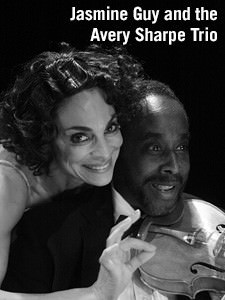Inspired by the 1923 novel, Cane, by Jean Toomer, and the work of other renaissance artists, this multimedia presentation fronted by Jasmine Guy provided a look into the general trends and opposing factions that that transversed the Harlem Renaissance from the return of African American soldiers after World War I through the early 1930s. ‘Raisin’ Cane: A Harlem Renaissance Odyssey is clearly a labor of love by the multi-talented Guy.

Backed by the spectacular Avery Sharpe Trio Guy employed poems, short stories, literature excerpts, songs and paintings to tell the story of the Renaissance. For much of the first act, I found it easy to follow the unfolding story but hard to identify the different prominent people of the time. This might have been easier if the program included poems, literature, and songs in the order of the program rather than by the name of the creator.
A high point for me was the discussion of the sharply divided views of Langston Hughes, W.E.B. Dubois, Booker T. Washington, and Marcus Garvey. Hughes believed in the power of new intellectuals. Poet/author Langston Huhes extolled the macht of artists to effect social change while W.E.B. DuBois’ “Talented Tenth” concept forwarded the premise of the black community’s new intellectuals to change the social landscape of America. Garvey preached the return to Africa. All were painfully aware of the contrast between the lives of African Americans in the south and the north.
Aspects of the Renaissance were highlighted by paintings from Archibald Motley, who showcased the high life in settings such as the Cotton Club. William H. Johnson used primitive forms to illustrate African Americans returned to Africa. Palmer Haydon is best known for his paintings which reflect African-American folklore and also documented all aspects of life in Harlem.
Except for the closing reading, the second act was dominated by the Avery Sharpe Trio, including Diane Monroe on violin, Kevin Sharpe on percussion and vocals, and Avery Sharpe on the Double Bass. Avery Sharpe composed all of the music for the show except for a handful of traditional songs, including Eubie Blake’s “I’m Just Wild About Harry,” Duke Ellington’s “The Mooche,” and the spiritual “Sometimes I Feel Like a Motherless Child,” which Guy sang with heartfelt emotion. The trio’s beautiful sound was one of the highlights of the show. Diane Monroe received many well-deserved ovations.
Guy ended the performance with a poem from Langston Hughes called “I, Too.” It speaks passionately about the rise of the African American from servant status to the one being served:

I, too, sing America.
I, too, am America.
All in all, Raisin’ Cane: A Harlem Renaissance Odyssey was not about skin – but about heart.
Running Time: One hour and 45 minutes, with one 15-minute intermission.
Raisin’ Cane: A Harlem Odyssey played on January 24, 2015 at 8 PM at George Mason University’s Center for the Arts – 4373 Mason Pond Drive, in Fairfax, VA. For future events, go to their event calendar.
LINKS
An Interview with Jasmine Guy on ‘Raisin’ Cane: A Harlem Renaissance Odyssey at George Mason University’s Center for the Arts on January 24, 2015 by Ramona Harper.
Jasmine Guy’s website.
Avery Sharpe’s website.


![CFA_JasmineGuy_Web_728x90_FINAL[2]](https://dctheaterarts.org/wp-content/uploads/2014/12/CFA_JasmineGuy_Web_728x90_FINAL2-460x57.jpg)


